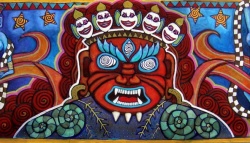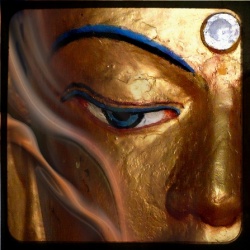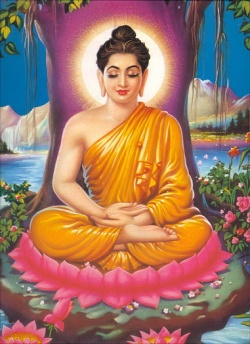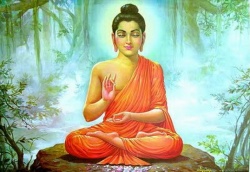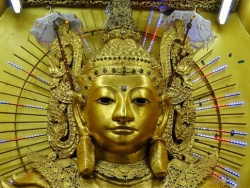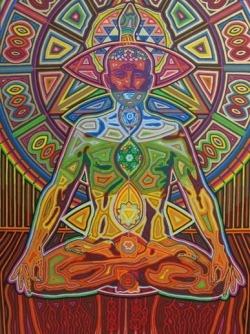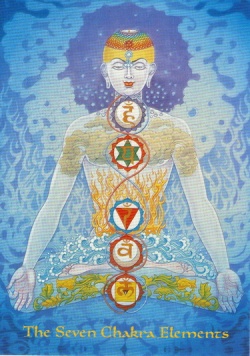Difference between revisions of "Pratītyasamutpāda"
| Line 226: | Line 226: | ||
[[Category:Death & Rebirth]] | [[Category:Death & Rebirth]] | ||
[[Category:Buddhist Terms]] | [[Category:Buddhist Terms]] | ||
| + | [[Category:Buddhist Cosmology]] | ||
| + | [[Category:Karma]] | ||
Revision as of 06:45, 23 May 2013
Pratītyasamutpāda (Sanskrit; Pali:Paticcasamuppāda) is commonly translated as Dependent origination or Dependent arising. The term is used in the Buddhist teachings in two senses:
- On a general level, it refers to one of the central concepts in the Buddhist tradition—that all things arise in dependence upon multiple causes and conditions.
- On a specific level, the term is also used to refer to a specific application of this general principle—namely the twelve links of Dependent origination.
The concept of pratītyasamutpāda (in both the general and specific meanings) is the basis for other key concepts in Buddhism, such as Karma and Rebirth, the arising of Dukkha (Suffering), and the possibility of liberation through realizing no-self (anatman). The general principle of pratītyasamutpāda (that everything is interdependent) is complementary to the concept of emptiness (Sunyata).
Meanings of Pratītyasamutpāda
Pratityasamupada is a Sanskrit term that has been translated into English in a variety of ways. The most common translations are Dependent origination or Dependent arising. But the term is also translated as interdependent co-arising, conditioned arising, conditioned genesis, etc. The term could be translated somewhat more literally as arising in dependence upon conditions. The Dalai Lama explains:
- In Sanskrit the word for dependent-arising is Pratityasamutpada. The word pratitya has three different meanings–meeting, relying, and depending–but all three, in terms of their basic import, mean dependence. Samutpada means arising. Hence, the meaning of Pratityasamutpada is that which arises in dependence upon conditions, in reliance upon conditions, through the force of conditions.
The term is used in the Buddhist tradition in a general and a specific sense, namely the general principle of interdependent causation and its application in the Twelve Nidanas. Generally speaking, in the Mahayana tradition, Pratityasamutpada (Sanskrit) is used to refer to the general principal of interdependent causation, whereas in the Theravada tradition, Paticcasamuppāda (Pali) is used to refer to the Twelve Nidanas.
The principle of interdependent causation
Overview
The general or universal definition of Pratityasamutpada (or "Dependent origination" or "Dependent arising" or "interdependent co-arising") is that everything arises in dependence upon multiple causes and conditions; nothing exists as a singular, independent entity. A traditional example used in Buddhist texts is of three sticks standing upright and leaning against each other and supporting each other. If one stick is taken away, the other two will fall to the ground. Thich Nhat Hanh explains:
- Pratitya samutpada is sometimes called the teaching of cause and effect, but that can be misleading, because we usually think of cause and effect as separate entities, with cause always preceding effect, and one cause leading to one effect. According to the teaching of Interdependent Co-Arising, cause and effect co-arise (samutpada) and everything is a result of multiple causes and conditions... In the sutras, this image is given: "Three cut reeds can stand only by leaning on one another. If you take one away, the other two will fall." For a table to exist, we need wood, a carpenter, time, skillfulness, and many other causes. And each of these causes needs other causes to be. The wood needs the forest, the sunshine, the rain, and so on. The carpenter needs his parents, breakfast, fresh air, and so on. And each of those things, in turn, has to be brought about by other causes and conditions. If we continue to look in this way, we'll see that nothing has been left out. Everything in the cosmos has come together to bring us this table. Looking deeply at the sunshine, the leaves of the tree, and the clouds, we can see the table. The one can be seen in the all, and the all can be seen in the one. One cause is never enough to bring about an effect. A cause must, at the same time, be an effect, and every effect must also be the cause of something else. Cause and effect inter-are. The idea of first and only cause, something that does not itself need a cause, cannot be applied.
This is, because that is
A key expression of the principle of Pratityasamutpada is found in many sutras:
- This is, because that is.
- This is not, because that is not.
- This ceases to be, because that ceases to be.
Rupert Gethin explains "..the succinct formula state[s] baldly that the secret of the universe lies in the nature of causality—the way one thing leads to another." Thich Nhat Hanh states: "these sentences occur hundreds of times in both the Northern and Southern transmissions. They are the Buddhist genesis."
Multiple causes and conditions
A key attribute of the principle of Pratityasamutpada is that every result or outcome is the result of multiple causes and conditions. Rupert Gethin explains:
- ...the Theravāda tradition records...as a fundamental axiom the principle that a single cause does not give rise to either a single result or several results; nor do several causes give rise to just one result; but rather several causes give rise to several results.
Relation to other Buddhist concepts
The Four Noble Truths
- See also:Four Noble Truths
The principle of Dependent origination is closely related to the Four Noble Truths. Contemporary scholar Peter D. Santina explains:
- What is it that the Four Noble Truths and Dependent origination have in common? The principle that both have in common is the principle of causality—the law of cause and effect, of action and consequence. ...we have mentioned that the Four Noble Truths are divided into two groups. The first two—Suffering and the causes of Suffering, and the last two—the end of Suffering and the path to the end of Suffering. In both of these groups, it is the law of cause and effect that governs the relationship between the two. In other words, Suffering is the effect of the cause of Suffering; and similarly, the end of Suffering is the effect of the path to the end of Suffering. Here too in regard to Dependent origination, the fundamental principle at work is that of cause and effect. In Dependent origination, we have a more detailed description of what actually takes place in the causal process.
Karma
- See also:Karma
The principle of Dependent origination underpins the concept of Karma, which is an application of this principle to individual actions and their fruition. Sogyal Rinpoche explains:
- In simple terms, what does Karma mean? It means that whatever we do, with our Body, speech, or mind, will have a corresponding result. Each action, even the smallest, is pregnant with its consequences. It is said by the masters that even a little poison can cause Death and even a tiny seed can become a huge tree. And as Buddha said: “Do not overlook negative actions merely because they are small; however small a spark may be, it can burn down a haystack as big as a mountain.” Similarly he said: “Do not overlook tiny good actions, thinking they are of no benefit; even tiny drops of water in the end will fill a huge vessel.” Karma does not decay like external things, or ever become inoperative. It cannot be destroyed “by time, fire, or water.” Its Power will never disappear, until it is ripened. Although the results of our actions may not have matured yet, they will inevitably ripen, given the right conditions.
As in the principle of Dependent origination, within the functioning of Karma, every fruition is said to depend upon multiple causes and conditions. Sogyal Rinpoche explains:
- The results of our actions are often delayed, even into future lifetimes; we cannot pin down one cause, because any event can be an extremely complicated mixture of many karmas ripening together.
Bhikkhu Thanissaro emphasizes the same point; he states:
- ...one of the many things The Buddha discovered in the course of his awakening was that causality is not linear. The experience of the present is shaped both by actions in the present and by actions in the past. Actions in the present shape both the present and the future. The results of past and present actions continually interact. Thus there is always room for new input into the system, which gives scope for free will.
No-self (anatman)
- See also:Anatman
The principle of Dependent origination also applies to the concept of no-self (anatman). The concept of no-self or anatman or emptiness of self is that it is not possible to identify an independent, inherently existing self; that the self only exists in dependence upon causes and conditions. This theory can be broken down as follows:
- If you look for the self within the Body, you can not find it there, since the Body itself is dependent upon its parts.
- If you look for the self within the mind, you can not find it there, since the mind can only be said to exist in relation to external objects; therefore the mind is also dependent upon causes and conditions outside of itself.
- Hence, since the self can not be said to exist within the Body or mind, it is said to be "empty of inherent existence".
Emptiness (Sunyata)
- See also:Sunyata
In the Mahayana tradition, the principle of pratītyasamutpāda is said to compliment the concept of emptiness (Sunyata). It is said that because all things arise in dependence upon causes and conditions, they are empty of inherent existence.
For example, in the twenty-fourth chapter of his Treatise on the Middle Way, Nagarjuna states:
Whatever arises dependently
Is explained as empty.
Thus dependent attribution
Is the Middle Way.
Since there is nothing whatever
That is not dependently existent,
For that reason there is nothing
Whatsoever that is not empty.
Geshe Sonam Rinchen explains the above quote as follows: "Here Nagarjuna states the Madhyamika or Middle Way position. Everything that exists does so dependently and everything that is dependently existent necessarily lacks independent objective existence."
The Twelve Nidanas
- See also:Twelve Nidanas
The Twelve Nidanas are a series of causal links that explain the process of samsaric Rebirth and hence the arising Dukkha, as well as the possibility to revert this process, and hence liberate oneself from Samsara. Within the Theravada Buddhist tradition, the Twelve Nidanas are considered to be the most significant application of the principle of Dependent origination.
The relationship between links (nidanas) is not considered to be a linear causal process, in which each link gives rise to the next link. Rather, each link in the process arises in dependence upon multiple causes and conditions. For example, whenever there is ignorance, Craving and clinging invariably follow, and Craving and clinging themselves indicate ignorance.
The thrust of the formula is such that when certain conditions are present, they give rise to subsequent conditions, which in turn give rise to other conditions and the cyclical nature of life in Samsara can be seen. This is graphically illustrated in the Bhavacakra (Wheel of Life).
The Twelve Nidanas and their causal relationships can be expressed as follows:
| English Terms | Sanskrit Terms |
|---|---|
| With Ignorance as condition, Mental Formations arise | With Avidyā as condition, Saṃskāra arises |
| With Mental Formations as condition, Consciousness arises | With Saṃskāra as condition, Vijñāna arises |
| With Consciousness as condition, Mind and Matter arise | With Vijñāna as condition, Nāmarūpa arises |
| With Mind and Matter as condition, Sense Gates arise | With Nāmarūpa as condition, Ṣaḍāyatana arises |
| With Sense Gates as condition, Contact arises | With Ṣaḍāyatana as condition, Sparśa arises |
| With Contact as condition, Feeling arises | With Sparśa as condition, Vedanā arises |
| With Feeling as condition, Craving arises | With Vedanā as condition, Tṛṣṇā arises |
| With Craving as condition, Clinging arises | With Tṛṣṇā as condition, Upādāna arises |
| With Clinging as condition, Becoming arises | With Upādāna as condition, Bhava arises |
| With Becoming as a condition, Birth arises | With Bhava as condition, Jāti arises |
| With Birth as condition, Aging and Dying arise | With Jāti as condition, Jarāmaraṇa arises |
Understanding within the Buddhist traditions
Theravāda
Within the Theravada Buddhist tradition, the Twelve Nidanas are considered to be the most significant application of the principle of Dependent origination.
Also in the Theravada tradition, the following key teachings on the principle of Dependent origination are found in the Pali suttas:
- Śāriputra’s introduction to the teaching of The Buddha was in the form of the following summary verse recited to him by the Monk Aśvajit: "Of those dharmas which arise from a cause, the Tathāgata has stated the cause, and also the cessation; such is the teaching of the Great Ascetic."
- Another formula states the principle of causality (idaṃpratyayatā) as ‘this existing, that exists; this arising, that arises; this not existing, that does not exist; this ceasing, that ceases’.(Majjhima Nikāya iii. 63; Samyutta Nikāya v. 387; etc.)
Mahayana
Madhyamaka
- See also:Madhyamaka
In the Madhyamaka, to say that an object is "empty" is synonymous with saying that it is dependently originated. Nāgārjuna equates emptiness with Dependent origination in Mūlamadhyamakakārikā 24:18. In his analysis, any enduring essential nature (Svabhāva) would prevent the process of Dependent origination, would prevent any kind of origination at all, for things would simply always have been and will always continue to be, i.e. as existents (bhāva). Madhyamaka suggests that impermanent collections of causes and conditions are designated by mere conceptual labels, which also applies to the causes and conditions themselves and even the principle of causality itself since everything is dependently originated (i.e. empty). If unaware of this, things may seem to arise as existents, remain for a time and then subsequently perish.
Hua Yen school
- See also:Huayan school
The Hua Yen school taught the Doctrine of the mutual containment and interpenetration of all phenomena, as expressed in Indra's net. One thing contains all other existing things, and all existing things contain that one thing. This philosophy is based in the tradition of the great Madhyamaka scholar Nagarjuna.
Avatamsaka Sutra
- See also:Avatamsaka Sutra
The Avatamsaka Sutra, regarded by D.T. Suzuki as the crowning achievement of Buddhist Philosophy, elaborates in great detail on the principal of Dependent origination. This Sutra describes a cosmos of infinite realms upon realms, mutually containing one another.
Comparative studies
Quantum mechanics
The Mahayana presentation of pratītyasamutpāda (and Shunyata) has been compared to the scientific theory of quantum mechanics (also known as quantum physics)—the contemporary branch of physics that examines matter on atomic and subatomic levels. For example, contemporary Tibetan Buddhist teacher Mingyur Rinpoche states:
- In my conversations with modern scientists, I’ve been struck by a number of similarities between the principles of quantum mechanics and the Buddhist understanding of the relationship between emptiness and appearance. Because the words we used were different, it took me quite a while to recognize that we were talking about the same thing—phenomena unfolding moment by moment, caused and conditioned by an almost infinite number and variety of events.
And contemporary Western philosopher Christian Thomas Kohl states:
- There is a surprising parallelism between the philosophical concept of reality articulated by Nagarjuna and the physical concept of reality implied by quantum physics. For neither is there a fundamental core to reality, rather reality consists of systems of interacting objects. Such concepts of reality cannot be reconciled with the substantial, subjective, holistic or instrumentalistic concepts of reality which underlie modern modes of thought.
Western theories of the origin of the universe
The principle of pratītyasamutpāda is the basis for the Buddhist view that it is not possible to identify a beginning or origin of the world or universe. According to the Buddhist view, since all phenomena are dependent upon multiple causes and conditions, it can not be said that there was a first cause or event that sparked the creation of the universe. Thus Buddhist Philosophy refutes the concepts of either a creator god or an initial event as posited in the "big bang theory". Dhammananda Maha Thera explains:
- Modern science says that some millions of years ago, the newly cooled earth was lifeless and that life originated in the ocean. Buddhism never claimed that the world, sun, moon, stars, wind, water, days and nights were created by a powerful god or by a Buddha. Buddhists believe that the world was not created once upon a time, but that the world has been created millions of times every second and will continue to do so by itself and will break away by itself. According to Buddhism, world systems always appear and disappear in the universe.
Western philosophy
Similarities
Jay Garfield points out the similarities between pratītyasamutpāda and the philosophies of Hume, Kant, and others. Garfield states:
- The analysis of causation can often look like a highly technical aside in philosophy. It might not seem at first glance to be one of the really "big" questions, like those concerning what entities there are, what the nature of mind is, what the highest good is. By contrast, causation often appears to the outsider or to the beginner like one of those recherche corners of philosophy that one has to work one's way into. But of course even in the history of Western metaphysics and epistemology it has always been central. One has only to think of the role of a theory of causation for Hume, Kant, Schopenhauer, or Wittgenstein to see this. This study of the Mulamadhyamikakarika shows why: a clear understanding of the nature of the causal relation is the key to understanding the nature of reality itself and of our relation to it. For causation is, as Hume, Kant, and Schopenhauer as well as Nagarjuna emphasize, at the heart of our individuation of objects, of our ordering of our experience of the world, and of our understanding of our own agency in the world. Without a clear view of causation, we can have no clear view of anything.
Relation to metaphysics
The concept of pratītyasamutpāda has also been compared to the Western philosophy of metaphysics (the study of the nature of being and the world). Bhikkhu Thanissaro explains that The Buddha did not intend to put forth a system of metaphysics:
- The Buddha was very clear on the point that he did not mean for his teachings to become a metaphysical system or for them to be adhered to simply for the sake of their truth value. He discussed metaphysical topics only when they could play a role in skillful behavior. Many metaphysical questions—such as whether or not there is a soul or self, whether or not the world is eternal, whether or not it is infinite, etc.—he refused to answer, on the grounds that they were either counterproductive or irrelevant to the task at hand: that of gaining escape from the stress and Suffering inherent in time and the present.
However, scholars have noted the similarities between pratītyasamutpāda and metaphysics. One source (Hoffman, 1996) asserts that pratītyasamutpāda should not be considered a metaphysical Doctrine in the strictest sense, since it does confirm or deny specific entities or realities. Noa Ronkin notes that while The Buddha suspends all views regarding certain metaphysical questions, he does not deny the significance of the questions.
Radical phenomenology
Bhikkhu Thanissaro relates the Buddhist concept of Karma to the modern philosophy of radical phenomenology; he sates:
- To avoid the drawbacks of the narrative and cosmological mind-sets, The Buddha pursued an entirely different tack—what he called “entry into emptiness,” and what modern philosophy calls radical phenomenology: a focus on the events of present consciousness, in and of themselves, without reference to questions of whether there are any entities underlying those events. In The Buddha’s case, he focused simply on the process of kammic cause and result as it played itself out in the immediate present, in the process of developing the skillfulness of the mind, without reference to who or what lay behind those processes. On the most basic level of this mode of awareness, there was no sense even of “existence” or “nonexistence”..., but simply the events of stress, its origination, its cessation, and the path to its cessation, arising and passing away.
Application to deep ecology
One of the basic ideas behind The Buddha's teaching of mutual interdependence is that ultimately there is no demarcation between what appears to be an individual creature and its environment. Harming the environment (the nexus of living beings of which one forms but a part) is thus, in a nontrivial sense, harming oneself. This philosophical position lies at the heart of modern-day deep ecology and some representatives of this movement (e.g. Joanna Macy) have shown that Buddhist Philosophy provides a basis for deep ecological thinking.
Alternate translations
The term pratītyasamutpāda been translated into English as follows:
- Causal interdependence (Christina Feldman)
- Conditioned arising (Peter Harvey)
- Conditioned genesis (Walpola Rahula)
- Dependent arising (Jay Garfield)
- Dependent co-arising (Bhikkhu Thanissaro, Dhammananda Maha Thera)
- Dependent origination (Christina Feldman, Peter D. Santina, Encyclopædia Britannica)
- Interdependent arising
- Interdependent co-arising (Thich Nhat Hanh)
